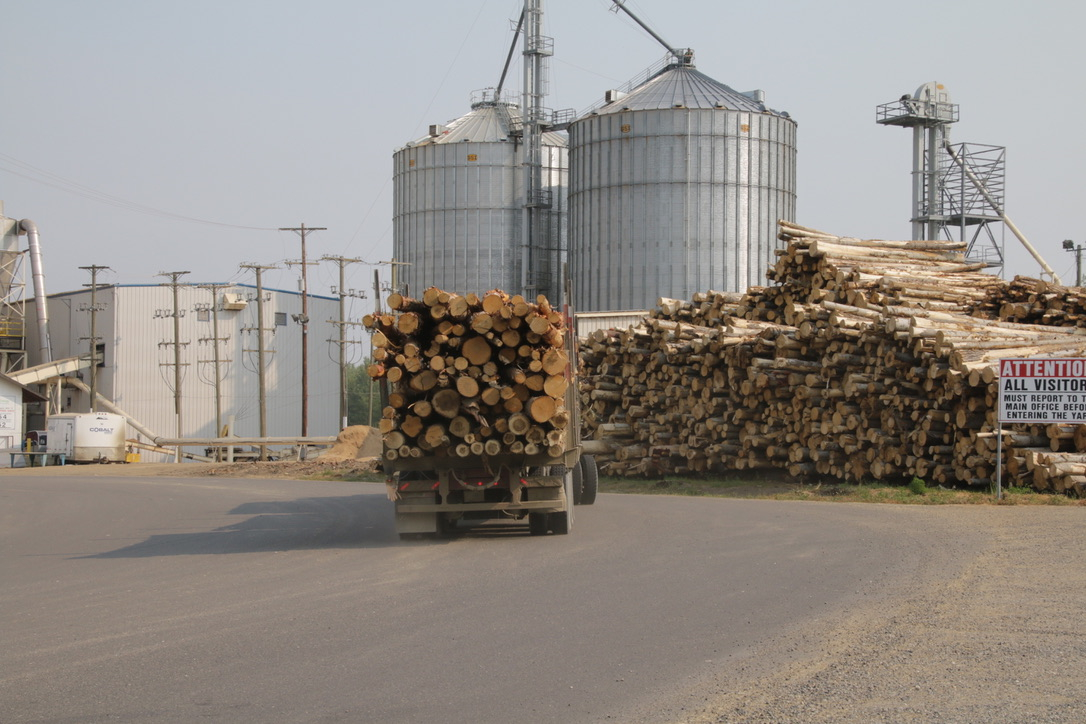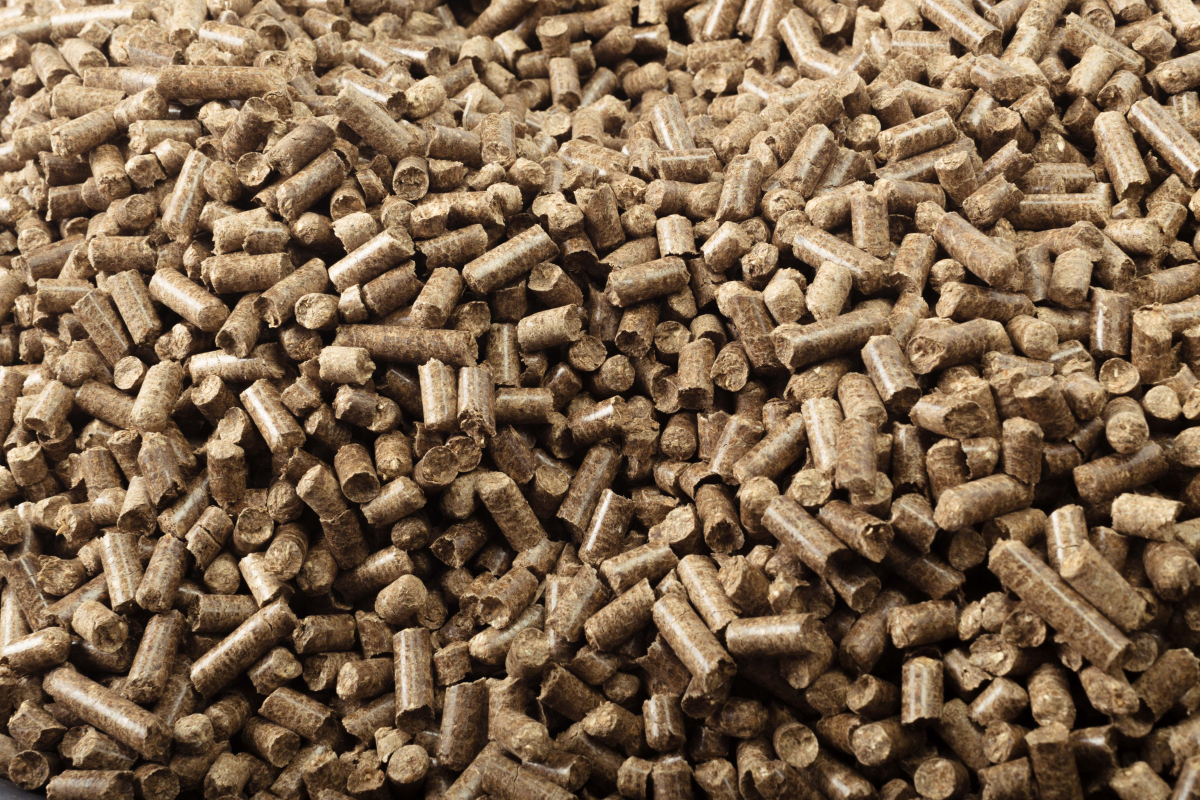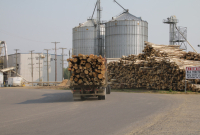Support strong Canadian climate journalism for 2025
Clear-cutting old-growth forests to produce wood pellets to replace fossil fuels in electricity generation would release more carbon into the atmosphere than it would save “for many decades,” according to a new scientific study.
The findings raise questions about the wood pellet industry’s claims that their product is “carbon neutral” and that switching from burning coal to burning pellets would reduce “100 per cent” of greenhouse gas emissions. Greenpeace Canada, which partially funded the study, said it has “huge implications” for Canadian policy.
But the Forest Products Association of Canada (FPAC), a group representing timber, pulp and paper producers, said the study is based on a “hypothetical” scenario that doesn’t represent the sector’s current practices and commitments, including to sustainable forest management and the low-carbon transition.
'Unlikely to be useful' in fighting climate change
The manufacturing of wood pellets, made by compacting together wood material, has been embraced by B.C. Premier John Horgan as a way to create “good jobs” while turning "waste" into "clean, renewable electricity.” Pellets are one of several bioenergy sources being examined as fossil fuel alternatives. Canada is now the second-largest wood pellet exporter worldwide, and Vancouver is home to the third-largest global supplier.
In a study published April 11 in the peer-reviewed scientific journal Climatic Change, Jay Malcolm and Paul Piascik from the University of Toronto and Bjart Holtsmark from Statistics Norway looked at the emissions of harvesting and processing timber, the pellet manufacturing process, transportation to a power plant and combustion for fuel, and measured it against other elements such as carbon savings from coal, forest regrowth and wildfires.
The researchers found that clear-cutting undisturbed, or “primary” boreal forests for material to make wood pellets, in order to replace fossil fuels in electricity generation, is “unlikely to be useful in mitigating climate change in the near term” — and, in fact, would be likely to “exacerbate carbon dioxide emissions for many decades.”
While it would ultimately help reduce carbon pollution in the atmosphere compared to continuing to use fossil fuels, the study says that, even under a best-case scenario where the forest is left to regenerate for a century, it would not reach the point of carbon neutrality for more than 90 years.
Malcolm said this is because old-growth forests are a “carbon-rich landscape” that can’t be easily replaced. “When people think about forests and carbon, they tend to get fixated on the fact that, as trees grow, they absorb carbon out of the atmosphere. So people get fixated with this idea of, ‘Oh, we want to have lots of young, active, fast-growing trees,’” he said.
“You can’t forget about the fact that forests, as they are right now, store a lot of carbon that’s not in the atmosphere. You don’t want to liberate that carbon, you want to keep it in the landscape...if you want to help the climate, you shouldn't be doing clear-cutting of unmanaged forests, or primary forests.”
The team studied a slice of northern Ontario for their research, in the area around Lake Abitibi that straddles the Quebec border. The research was funded by Greenpeace Canada and by a discovery grant from the Natural Sciences and Engineering Research Council of Canada.
“I think this has huge implications for Canada in terms of policy with forestry,” said Greenpeace Canada nature and food campaigner Reykia Fick.
“What we need to be doing is moving towards focusing on disturbed forests, or already-harvested forests, and moving towards longer harvesting periods and lighter harvesting techniques. It just illustrates the importance of these forests from a climate perspective, and the importance that we should be placing on protecting them.”

Industry calls study 'hypothetical and atypical'
Questions sent to two directors at the Wood Pellet Association of Canada on May 8 concerning the study were not returned before publication.
In a statement sent May 10, Robert Larocque, senior vice president of FPAC, the forest products industry group, said the scenario being evaluated in the study was “hypothetical and atypical.”
He said an examination of a “more real-world situation of a portfolio of wood products,” instead of one that zeroed in on wood pellets, was “strangely absent in the discussion.”
The forest products sector has a “commitment to waste reduction and advancing a lower carbon economy,” said Larocque, and he argued that “most” pellets produced in Canada are from “wood waste,” or leftover material from sawmills such as sawdust or small tree branches.
The industry uses “what would otherwise be wood waste to make products we need like word pellets, toilet paper, medical masks and hospital gowns, sanitary wipes, and paper towels,” he said.
Not all wood pellet manufacturing comes from waste, however. The B.C. government told National Observer on April 27 that timber harvesting has “evolved" and that the industry now sends logs not suitable for manufacturing due to age or fire damage to facilities such as pellet mills.
Larocque also argued that in Canada’s managed forests — the areas used for logging, fire management and parkland, which represent about 65 per cent of Canada’s total forested area — the activities of the industry and the wood products harvested from them represent a carbon sink.
Environment and Climate Change Canada's National Inventory Report, released last month, says the net balance of “managed” forest land amounted to 150 million tonnes of carbon dioxide removed in 2018, while emissions from wood products coming from managed forests was 125 million tonnes that year.
But the bottom line, said Malcolm, "is that the standard way we harvest wood in the boreal forest in Canada is not a good idea if you're trying to help the atmosphere."
Carl Meyer/Local Journalism Initiative/Canada’s National Observer






Comments
Wood "waste" can also be used to manufacture useful construction grade wood products, you don't have to burn it. There is probably wood waste buried in our landfills because manufacturers haven't figured out how to recycle it. By the time they do it will likely have rotted though....
If the forest industry wants to make any kind of claim about burning wood as carbon neutral - surely you jest gentlemen? They had better get busy replanting with vigorously growing seedlings, the ground they have laid waste!!!
Even the US government has acknowledged that logging old-growth forests results in irrecoverable carbon loss "Harvesting old-growth forests for their forest products is not an effective carbon conservation strategy because the carbon remaining in the wood products plus the regrowth are not enough to compensate for the loss of large carbon stocks in the intact forests"
Synthesis https://www.fs.usda.gov/ccrc/topics/forests-carbon
This paper shows about half of all forest carbon is stored by the biggest trees covering only about 1 % of the forest land base – BC's last endangered high productivity old-growth forests still being targeted by industry
https://onlinelibrary.wiley.com/doi/full/10.1111/geb.12747
We need immediate action to protect the last old-growth.
"As a party to the United Nations Framework Conference on Climate Change (UNFCCC), Canada must report annually on greenhouse gas (GHG) emissions from the 'managed forest'.
The 'managed forest' is made up of all forests under 'direct human influence'. It's a subset of Canada's total forest area and includes forests managed for harvesting, forests subject to fire or insect management, and protected forests such as those found in national and provincial parks.
In 2015, total net emissions of carbon dioxide equivalent (CO2e) from Canada's 'managed forest' were about 221 million tonnes (Mt).
Total net emissions are calculated by adding emissions/removals caused by human activities to emissions /removals caused by large-scale natural disturbances (e.g. wildfires, insect infestations such as the mountain pine beetle) in Canada's managed forest.
Human activities in Canada's managed forest accounted for removals of about 26Mt CO2e in 2015, while large scale natural disturbances accounted for emissions of about 247 Mt CO2e in 2015."
(source: Natural Resources Canada, Nov 28, 2017: Indicator: Forest carbon emissions and removals)
In its Second Biennial Report submission to the UNFCC (April 2016), section 5.1 footnote, Canada has indicated that its accounting for "managed forests" towards its emissions reductions target will "exclude" the impacts of "natural disturbances" because those impacts are "non-anthropogenic".
That policy will allowed Canada, by suppressing GHG emissions from natural disturbances (caused in large part by human activities), to show in its future report to the UNFCCC that Canada's "managed forest" (as promoted by the forest industry) is a "sink" instead of a "source" of GHG. That's called playing with numbers.
Talking about playing with numbers, Environment and Climate Change Canada, on pretext of accounting changes, has lowered total annual Canada's national greenhouse gas emissions for every year since 1990 (e.g. total emissions in 2014 went from 729 Mt CO2e in the 2015 report to 716 Mt in the 2017 report, a reduction of 13 Mt). Very convenient as the federal government knows how far away it is to reach its GHG emissions reductions target.
This article yells the findings of the report in its headline while presenting the industry rebuttal as a quiet afterthought, even though the study DOES present a hypothetical situation that is not how wooden pellets are made (they are made from the byproduct of existing forestry, rather than cutting down trees to make pellets; whether there could be more productive uses of this material would be an interesting discussion). I'm all for reforms in the forestry industry, but let's make sure it's done with eyes wide open. Let's be careful to apply the same scrutiny to environmental voices/finding as we do to corporate/gov/others.